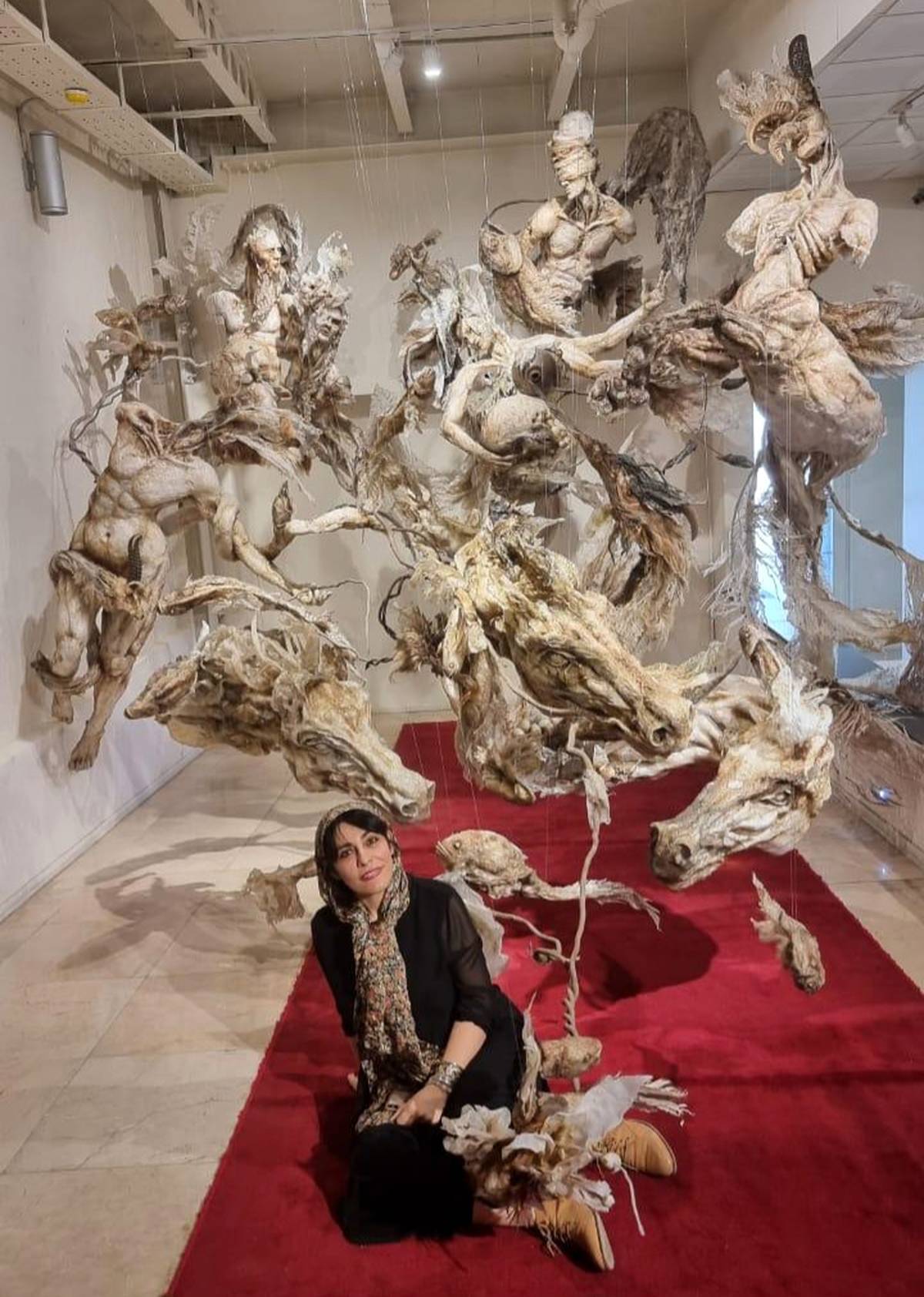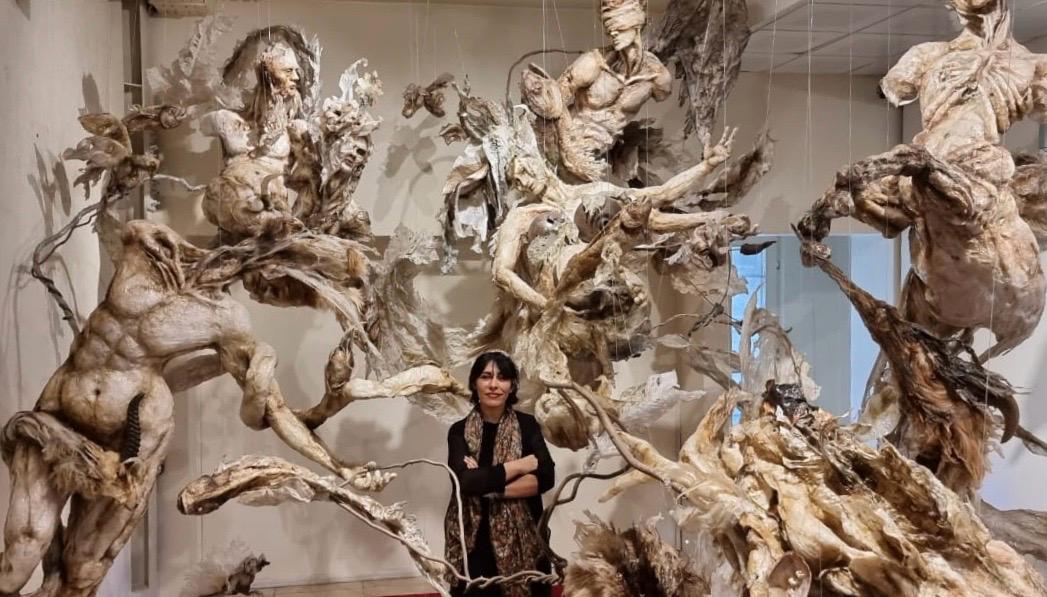
Bundahishn by Elham Fallahi 82 Sculptures in a Mythical Suspended Installation at Raha Gallery Collection
Bundahishn, an installation sculpture by Elham Fallahi, is a work about the philosophy of creation and mythical gods who are the protectors and guardians of nature. Suspended between earth and sky, the work occupies an impressive six by six by four meters in the private showroom of the Raha Gallery Collection.
ArtDayMe : The Raha Gallery Middle East Collection, Founded and directed by engineer Mohammadreza Ghaemmaghami, has been actively committed to cultural engagement in the region for over two decades. The collection preserves a rich array of modern and contemporary masterpieces by both Iranian and Arab artists.
One of these works is the amazing installation sculpture "Bundahishn" by Elham Fallahi.
The installation sculpture Bundahishn, created by Elham Fallahi using a mixed-media technique—including recycled and discarded materials from the environment, particularly nylon—comprises six large figures, seventy-six small sculptures, and connecting components. It was created in 2019 with the support of the Raha Gallery Middle East Collection. The construction of Bundahishn took two years and six months.
In Bundahishn, the ancient human mind is embodied through the narrative of the “first moment of creation.”

Ancient humans were caretakers and worshippers of nature, attributing sanctity and divinity to it, and venerating it as a godlike force.
Elham Fallahi’s unique conceptual approach in Bundahishn is to recreate ancient gods and mythical nature spirits using materials that are destructive to the environment.
Bundahishn: Summoning the Gods from the Heart of Waste
Bundahishn by contemporary artist Elham Fallahi, is a monumental installation that takes us into a forgotten world of myth, creation, and ecological catastrophe. The work, created using recycled materials, waste, and plastic, is suspended between earth and sky, producing a mysterious and ritualistic atmosphere in the private showroom of the Raha Gallery Collection.
Measuring six by six by four meters, Bundahishn rises before the viewer as a visual anthem of creation, nature's guardian gods, and the collapse of today’s ecosystem.

Hybrid creatures with twisting forms, ghostly horses, and deities that seem to have emerged from ancient texts and collective memory are recreated out of human waste—
as if nature, in order to survive, has called upon its ancient myths.
Beings caught between the moment of birth and death, embodying the dualities of pain and pleasure, fear and beauty, sorrow and joy.
Through upcycling, Elham Fallahi not only responds to the environmental crisis but also constructs the aesthetic structure of her work in simultaneous contrast and harmony with meaning.

Disjointed and varied textures, bone-like and earthy colors, and abstract, dynamic forms evoke a sense of decay and mysterious antiquity—
a world where gods rise not from light, but from the depths of plastic waste.
The spatial arrangement of the work is also notable. A red carpet extending beneath the suspended mass of figures evokes the feeling of entering a mysterious temple or sanctuary.
The overhead lighting emphasizes the layered structure of the work; as if the viewer is witnessing a piece that is simultaneously in the process of birth and collapse.
In an era where art is often confined to exhibitions and gallery walls, Fallahi, through this multimedia conceptual work, reintroduces art as a language of protest, myth-making, and environmental awakening.

Bundahishn represents a contemporary world in which humans, the environment, and forgotten archetypes are intertwined in a wounded yet unified body.
How was Bundahishn created?
Elham Fallahi said about the formation of this work:
“My process in creating such large-scale projects begins with sharing the core concept and design with the producer. Only then does the actual creation process begin.
Regarding Bundahishn—which, in addition to its mythological concept, has an environmental dimension—I spoke with Mr. Mohammadreza Ghaemmaghami, the founder and owner of the Raha Gallery Collection.
He is deeply concerned with environmental preservation, especially in relation to the sea, oceans, and marine life, and has been involved in numerous related activities for years.
Mr. Ghaemmaghami appreciated the idea, and we moved forward with its execution.”

She adds: “Bundahishn embodies three key aspects: art, honoring the environment, and creating employment for disabled artists. It was selected as a top idea in a national startup competition.”
Elham continues: “To create this work, we needed to collect and accumulate several hundred kilograms of plastic waste. Our first step in the project was raising awareness about environmental protection.
Thanks to Mr. Ghaemmaghami’s coordination, we organized a three-day cleanup with the help of students from the Maritime Technical School and schoolchildren from the islands of Hormuz, Qeshm, and Bandar Abbas to gather waste and discarded nylon from the waters and shores of the Persian Gulf.”

She explains: “The collected waste was transported to Tehran, where it was cleaned. Then we informed galleries and families to give us their recyclable waste before disposing of it.
Many artists supported us in this effort, creating a beautiful symbolic solidarity for environmental care.
Interestingly, among the waste were garments made from animal skins—which, in my view, represent the height of human savagery and wealth in today’s world.”
Fallahi adds: “With the help of nature-loving people, galleries, and factories, we amassed a large volume of clean yet used nylon. We needed a large space to store the raw materials.
Together with my team of young and disabled artists, we carefully prepared the materials. Based on my designs, I began constructing the work with my usual precision and care. The creation of this piece took two years and six months.”

A Floating Installation with No Pedestals Another remarkable feature of Bundahishn is the way it is presented and installed: suspended between earth and sky!
Despite comprising so many sculptures, the installation has no pedestal.
The artist’s decision to suspend the work evokes a sense of otherworldliness, abstraction, and detachment—
just as all ancient stories and mythical gods live on in human memory like dreams and legends.
Presence in Collections and the Art Market

Elham Fallahi’s works are housed in prestigious collections across the United States, Europe, and Iran, including:
• Raha Gallery Collection (Iran–Dubai)
• Mortazavi Foundation Collection (Iran–USA)
• Didi Museum & Gallery (Iran)
• Oak Tree Collection (USA)
• Clean City Collection (USA)
• Dang Collection (China)
• Marmar Gallery (USA)
• Rira Gallery (Dubai)
• And numerous private collections in Iran, France, Austria, Canada, the U.S., and China
The value of Elham Fallahi’s works has seen significant growth in recent years.
Her very small pieces—such as a life-sized rose—have sold for $2,500, while her large multi-figure installations have reached prices of up to $240,000 in her personal studio, galleries, and expos.
Her works have appeared in two auctions:
In January 2020 at Tehran Auction, her piece The Battle of Rakhsh and Homay—created in 2017 from recycled materials, measuring 120×100×150 cm—sold for four times its base price at 240 million toman (approx. $22,000 based on the exchange rate at the time).
A smaller work by Fallahi titled Horse Bust, measuring 50×40×30 cm, was sold at MAP Auction in the U.S. in 2021 for $10,000.

It is worth mentioning that Bundahishn has received extensive attention within the art community, and many museums and biennials have expressed interest in exhibiting it.
The installation sculpture Bundahishn by Elham Fallahi belongs to the Raha Gallery Middle East Collection.

LEAVE A RELPY